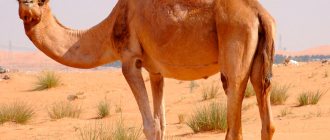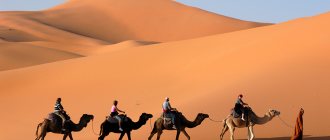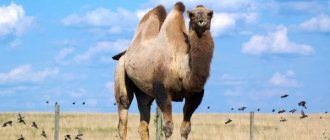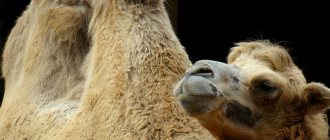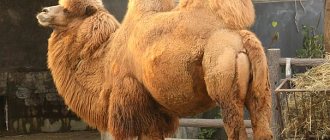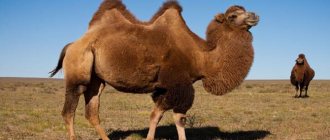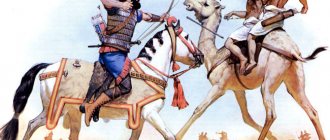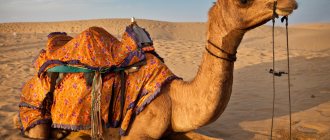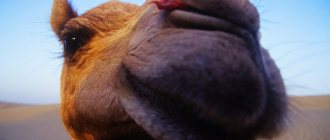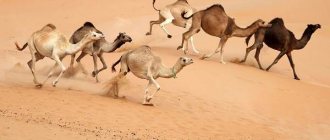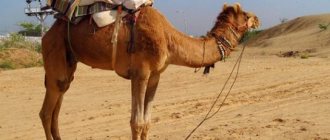- Wild animals
- >>
- Mammals
With the rapid development of scientific and technological progress, populations of beautiful wild fauna are reduced to smaller and smaller numbers. Many beautiful animals are disappearing. But nature made sure that every living creature on Earth was comfortable, creating all the necessary conditions for this. Just look at the diversity of species and subspecies of our smaller brothers, their specificity and behavioral characteristics. One of the amazing creations of wildlife is the dromedary camel , also called the dromedary or Arabian.
What does it look like
Dromedaries weigh much less than Bactrians: on average, this figure does not exceed 600 kg. Males usually do not weigh more than half a ton. One-humped camels are quite tall, as their height is approximately 2-3 meters. The body length of animals varies within the same values.
This species has a short tail, usually about 50 cm long. The animal has a rather elegant physique, so it can develop a higher speed than the Bactrian, namely about 20 kilometers per hour. The dromedary camel's neck is long and its head is elliptical in shape. The camel also has a split lip, but this is not the only feature of this species. The animals' nostrils have an interesting slit-like shape. The palate of male animals is soft; it swells during the rut, attracting females.
Callous growths can be found on the legs, but not only on the feet, but also on the curves of the lower and upper limbs. So, they are present on the knees and elbows. The hooves are replaced by these corpus callosum and fingers.
Camels have short hair, but it is quite thick on the back and neck. Although this does not make the species more adapted to the cold. The color of the animals is usually yellowish or brown, but albinos are also found.
Life in the desert
As for the physique, it is adapted to life in harsh arid deserts: a long curved neck, a narrow and elongated skull, small ears hidden in fur and protected from the sun and sand by long eyelashes and a nictitating membrane of the eye.
The camel's narrow slits of nostrils, which close tightly in critical situations, also protect the camel from sandstorms and loss of moisture.
Coarsened lips, adapted for tearing off thorny and tough vegetation, large calluses on the limbs for contact with the hot earth, and a two-toed foot that easily overcomes rocky and sandy landscapes also help to live in an arid environment.
The thick and slightly curly fur of a camel prevents moisture from evaporating on hot days and keeps you warm on cold nights. The hump on the back – the energy reserve of adipose tissue – also protects the animal from overheating.Where does it live?
In the past, dromedary camels lived in Africa and the Middle East, but today they can only be found on the African continent, in Africa and India, where they are used for carrying things and as transport. In the south, the boundary of the animals’ habitat is considered to be 13 degrees north latitude, and in the north – Turkestan. Despite the fact that the animals are domesticated, in Australia you can find herds that have gone wild. There are about 100 thousand heads there. At the moment, these are the last wild dromedary camels.
Wild and domestic camels
Unfortunately, camels are becoming less and less common in the wild. One-humped animals are not found in the natural environment at all, and the number of two-humped animals is only 1000 individuals, which live in special reserves. We talked about the name of the Bactrian camel, listed in the Red Book - it is Bactrian.
Having no enemies among the desert inhabitants, the camel is in danger due to human activity. On the one hand, animals are caught for domestication and domestication, and on the other, their habitats are destroyed.
Domestic camels are wayward, proud animals with a sense of self-esteem. They cannot tolerate cruelty or neglect. A camel will never get to its feet at the request of its owner unless it decides for itself that it has had a good rest. The camel will not allow herself to be milked by a stranger. This must be done by a specific person and exclusively in the presence of the baby camel. Despite difficult communication with humans, camels are very loyal animals, they become attached to a good owner, and are capable of learning and training.
What does it eat?
This species can easily survive without water, aided by its hump, which contains strategic reserves of fat. This is why individuals always have energy. It also helps that the animals do not have many sweat glands and have fur that prevents excessive evaporation of moisture. Sweat is released only when the body temperature exceeds 40 degrees. The camel feeds on bushes and parts of plants.
About a third of a camel's diet consists of poisonous saprophytes. Animals often eat parsley leaves, barnyard grass, reeds and even oats. Sometimes, in cases of severe hunger, they eat fish and carrion. They also love camel thorn. It is easy for them to get leaves from a height of three meters. They usually eat 10-20 kg of plants. The stomach of animals has several chambers, so poorly prepared food almost immediately enters the anterior stomach, where it is digested. The same processes occur in ruminants, which belong to the artiodactyls, which indicates the relatedness of the species. Although many scientists say that this is not true due to the presence of many glands in the anterior stomach.
What do they eat
Camels are unpretentious to food, and their fleshy, hard lips allow them to eat even vegetation that is not suitable for other herbivorous mammals. The basis of the diet is saxaul, solyanka, wormwood, camel thorn, sand acacia, and barnyard grass. After grazing, the camel regurgitates the swallowed vegetation and slowly chews it. The structural features of the digestive tract allow you to extract maximum benefit from the toughest and roughest food.
RHINOCEROS
Lifestyle
The dromedary camel is generally very slow. They always stick to their daily routine. Although the animals are sedentary, they can walk about 80 km every day. So, they are especially active during the day and morning. At this time, dromedary camels look for food, and later they prefer to rest on the sand. Animals do not move very fast, reaching a speed of only 10 km/h, but they can also gallop. Although they cannot maintain this speed for long.
In the wild, dromedaries create groups consisting of one male, several females and young animals. However, there are also groups where there is no one but males who are fighting for dominance. But such herds do not exist for long and become ordinary. Often, in a herd of camels, everything is calm and there are no conflicts, unlike the rutting period, when there is a fight for the female. In Turkey, during this period, aggressive animals are used for camel fighting.
Why does a camel have a hump?
A distinctive feature by which even children can easily recognize a camel is its hump. It is a mistake to believe that it contains a supply of water. No. Adipose tissue is concentrated in the hump - it contains nutrients that the animal consumes when necessary as food or drink. After all, it is known that water is a by-product of the breakdown of fat.
It is interesting that the well-being of an animal is judged by its humps. If they stick up, the camel is in excellent physical shape. Otherwise, the humps sag or disappear completely.
Reproduction
One-humped camels become sexually mature only at 3 or 5 years of age. Typically, females are ready to have offspring much earlier than males. When the rut begins, males actively mark their territory using special glands located on the back of their heads. They do this to protect the place, and if another male dares to approach, a fierce fight will begin, during which the animals will whistle and roar. The winner mates with the female, and immediately after mating begins to look for another.
The female is capable of bearing and giving birth to only one cub in two years. The child is in the mother's womb for 13 months. A female camel gives birth while standing, and when the baby camel is born, it can walk almost immediately. The mother feeds the cub for about six months, and then he himself begins to eat plants. Females can produce 7-10 liters of milk per day. The main difference from baby Bactrians is their size: small dromedaries are several times larger.
Origin of the species
Dromedaries are considered almost sacred animals in Arab countries; people think that they are a gift from Allah. People learned about dromedaries when the Bedouins began to come to Palestine about 3 thousand years ago. There are several versions about the origin of the species. The first says that some camel of the same kind overcame a long journey from America to Eurasia, and he was the ancestor of the first dromedaries. Another version tells us that the wild Arabian camel was domesticated by the Bedouins and in the future the descendants of the animal began to inhabit Uzbekistan. However, scientists do not agree that these animals were once wild, because there are very few remains of dromedaries. Although there are drawings of these bizarre animals on the rocks. They are numerous in Africa, where there was once a huge population of dromedary camels. A little further north, these animals could also be found, near Turkmenistan.
But now the species is not so common due to frost, but it tolerates hot weather well. The camel is distinguished by the fact that it moves quite quickly, which is why it was called that way - from the Greek. "dromaios", that is, fast. Another feature of the animal is that it produces a lot of milk, unlike Bactrian, and it can better quench thirst.
Benefits for humans
Man began domesticating camels quite a long time ago, almost 5 thousand years ago. In addition to physical assistance in transporting goods, animals provide valuable milk, high-quality leather, and warm fur. Even camel bone is used to make jewelry and household items for Bedouins. It’s not for nothing that animals are held in high esteem by those who breed them.
Many residents of tourist destination countries use camels to entertain visitors.
Without the participation of these hardy animals, trade in ancient times would not have taken place, and as a result, powerful civilizations would not have flourished. People would not have become acquainted with oriental spices or Chinese silk. Camels were also used in wars. By the way, there is still a camel regiment in India.
The camel also played a role in the development of North America. It was with the help of these animals that goods were transported. With the invention of the railroad, camels were moved out into the natural desert environment as unnecessary, where they were destroyed by local farmers. That's why there are no animals left in America.
Enemies
Dromedaries are large animals and therefore in the wild they have no particular enemies. But sometimes wolves can attack young animals. Previously, they were hunted by desert lions and tigers, but these animals became extinct long ago. However, humanity greatly harms dromedary camels, which is why there are currently no primary wild specimens. People use them to obtain food, namely delicious fatty milk.
Although camels themselves harm humanity, their influence is not so strong. For example, dromedaries can suffer from tuberculosis and transmit the disease to other pets. They also cause harm to agriculture, namely fruit plantations. In addition, dromedary camels often pollute the oasis and eat all the plants that are around it.
Interesting Facts
- Dromedary females carefully choose the person who will milk her. At this time, the cub should be nearby.
- Adults do not accept bad treatment and do not forget insults.
- If the camel is not rested or is sleeping, no one can raise it.
- Dromedaries are very vindictive and remember well all their offenders.
- Individuals of this species become attached to their owner and can come to him themselves if they are separated.
- Camels can swim.
- There are much more Dromedaries than Bactrians; such individuals make up about 94% of the total camel population.
- All tissues of a dromedary camel absorb moisture, including red blood cells.
- Animals' sense of smell is very well developed, because they sense approaching a pasture or oasis even 40 kilometers away. They also pay attention to the clouds and go where it will soon rain.
- A baby dromedary camel can weigh more than 100 kg.
- In the past, dromedaries were used for military purposes.
- They spend about half a day on the pasture. Animals eat on the go, limiting themselves to a couple of leaves, which they carefully chew about fifty times.
- Dromedars always keep their mouths closed and try to breathe regularly.
- In hot weather, animals press tightly against each other so that their body temperature drops.
- In a few minutes, a dromedary camel can drink more than 120 liters of moisture.
- Dromedaries love to rest on the sand and scratch their bodies with their hind legs.
- Camels do not have molars.
- Malte-Brun brought dromedaries to Australia in order to study the desert terrain of the country.
- The breed of dromedary camels that produces more milk is called Arvana. Females can bring 3-4 thousand liters per year.
- Dromedary running is an amble.
- Ferninand de' Medici promoted the breeding of this species near Pisa in 1622, when he introduced them to Italy.
- Mating in animals can last from 10 minutes to half an hour.
- One camel can produce several kg of wool per year.
